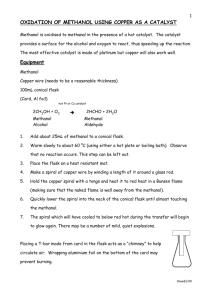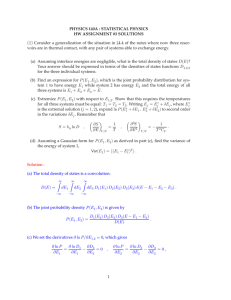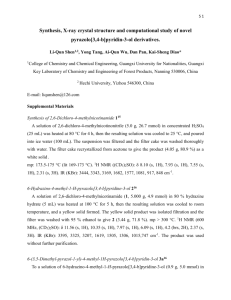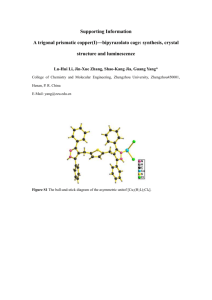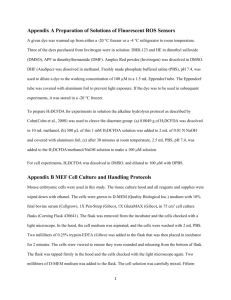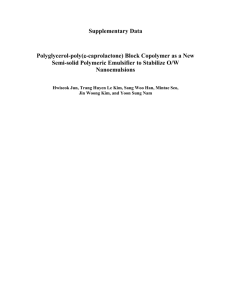jssc3519-sup-0001-SuppMat
advertisement
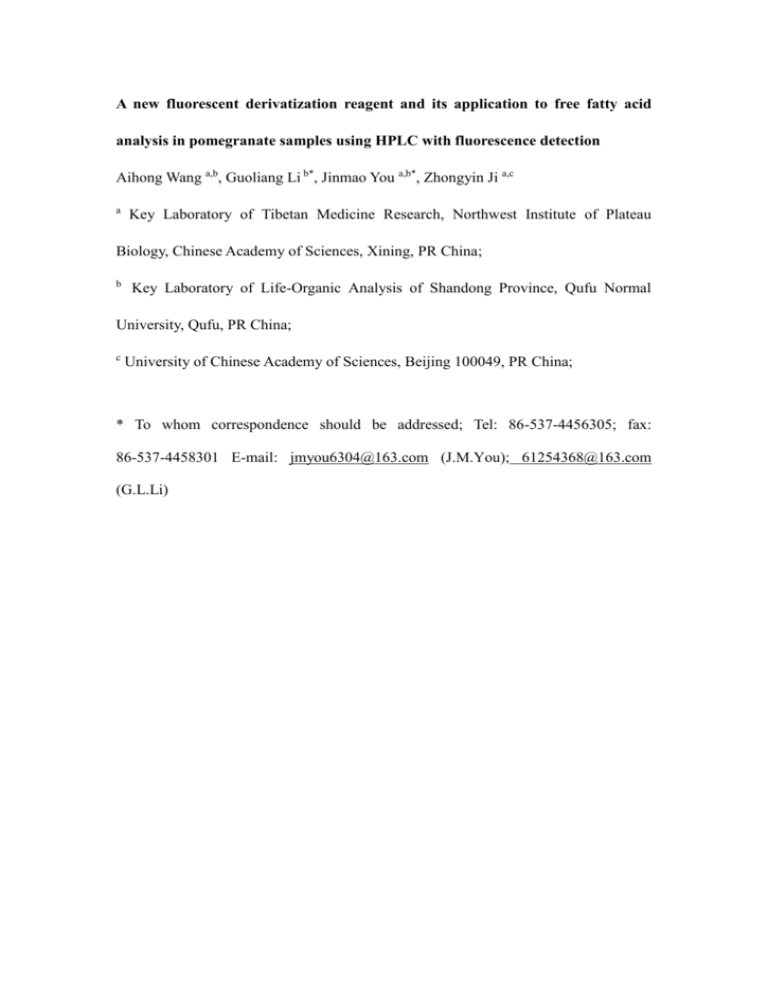
A new fluorescent derivatization reagent and its application to free fatty acid analysis in pomegranate samples using HPLC with fluorescence detection Aihong Wang a,b, Guoliang Li b*, Jinmao You a,b*, Zhongyin Ji a,c a Key Laboratory of Tibetan Medicine Research, Northwest Institute of Plateau Biology, Chinese Academy of Sciences, Xining, PR China; b Key Laboratory of Life-Organic Analysis of Shandong Province, Qufu Normal University, Qufu, PR China; c University of Chinese Academy of Sciences, Beijing 100049, PR China; * To whom correspondence should be addressed; Tel: 86-537-4456305; fax: 86-537-4458301 E-mail: jmyou6304@163.com (J.M.You); 61254368@163.com (G.L.Li) Synthesis of 2-(7-methyl-1H-pyrazolo-[3,4-b]quinoline-1-yl)ethyl-4-methyl benzenesulfonate (MBP) 1) Synthesis of 7-methyl-1H-pyrazolo[3,4-b]quinoline 2.33 g 2-chloro-7-methylquinoline-3-carbaldehyde, 85% hydrazine hydrate (2.3 mL) and 1 g p-toluenesulfonic acid were fully mixed in a 100 mL round- bottom flask. The mixture of the flask reacted for 40 min at 130°C, and the solid was washed with water after reaction. The resume was extracted two times with diluted hydrochloric acid and then combined filtrates. PH of solution was adjusted to 7-8 with sodium hydroxide and filtrated to get precipitated solid. The pure product was recovered by drying and recrystallization from methanol solution. The yield was 92%, mp. 229.5°C-230.2°C. Found, C 72.11, H 4.95; Calculated, C 72.08, H 4.92; IR (KBr), 1625.27 (C=N) 1439.69 (-CH3); 930.73, 905.21, 853.49, 773.78; MS: m/z [M+H]+, 184.1 2) Synthesis of 2-(7-methyl-1H-pyrazolo-[3,4-b]quinoline-1-yl)ethanol 5 g 7-methyl-1H-pyrazolo[3,4-b]quinoline, 4.3 g ethylene carbonate and a trace of KOH were added to a 500 mL round-bottom flask containing 100 mL DMF and then rapidly heated to reflux with stirring for 1 h. when the reaction was accomplished, the solution was concentrated using a rotary evaporator under the condition of oil bath heating. The resume was washed three times with water, then dried and recrystallized from methanol solution to produce a yellow needle crystal (yield: 80%, mp: 153.3°C-153.7°C). Found,C 68.70, H 5.77, N 18.49; Calculated, C 68.74, H 5.75, N 18.42; IR (KBr), 3264.60 (-OH); 2959.77, 2902.47 (C-H); 1616.82 (C=N); 1446.66 (-CH3); 1067.95 (-CH2-OH); 906.9, 824.9, 781.19; MS: m/z [M+H]+, 228.2. 3) Synthesis of 2-(7-methyl-1H-pyrazolo-[3,4-b]quinoline-1-yl)ethyl-4-methyl benzenesulfonate To a solution containing 3.7 g paratoluensulfonyl chloride and 30 mL anhydrous pyridine (0°C) in a 100 mL round-bottom flask equipped with magnetic stirring and a constant pressure drop funnel, 5 g 2-(7-methyl-1H-pyrazolo-[3,4-b]quinoline-1-yl)ethanol dissolved in 50 mL pyridine solution was then added dropwise within 30 min. After stirring at 0 ºC for 4 h, the contents were kept at ambient temperature for another 4 h period with vigorous stirring. After reaction, the solution was concentrated using a rotary evaporator. The residue was washed with water and then dried to produce the yellow solid. The crude products were recrystallized two times from methanol solution to give the yellow crystal (yield: 70%, mp: 117-118 ºC). Found, C 62.97, H 5.02, N 11.02, S 8.41; Calculated, C 62.94, H 5.09, N 11.08, S 8.35; IR (KBr), 1619.2 (C=N); 1448.3 (-CH3), 1361.81 (C-SO2-); 1189.03, 987.93 (ph-S-); 766.79, 666.17, 554.01; MS: m/z [M+H]+, 382.1 Table S1 Comparison of the proposed method with other methods Analytes Derivatization reagent Derivatization conditions Method LOD Ref. Pheromone gland extracts DMDS Methanol containing 5% HCL, 65 °C, 4 h Capillary GC-MS-EI (oven temperature up to 250 °C) 20 - 40 ng/mL [18] Conjugated fatty acid methyl esters MTAD Dichloromethane, 0°C, 10 s GC–MS (oven temperature up to 350 ºC) Human serum AMMP C3–C20 saturated fatty acids BrDMEQ Human serum 9-AP Benzene solution 45 min at 70 ºC CLA-rich soy oil PTAD Room temperature for 15 min, the solvent was evaporated. Nitraria tangutorum seed oil BDETS K2CO3, DMF, 90 ºC, 30 min Notopterygiumfo rbesii Boiss CPMS K2CO3, DMF, 90 ºC, 30 min Pomegranate MPB K2CO3, DMF, 90 ºC, 30 min BMP and CMP in 50 °C ,30 min Acetone or toluene, K2CO3, 18-crown-6, 60 ºC, 30–60 min CAN, LC/ESI-MS HPLC-FLD, λex = 370 nm, λem = 450 nm HPLC-FLD, λex = 303nm, λem = 376 nm LC/ESI-MS/MS HPLC-FLD, λex = 333 nm, λem = 390 nm HPLC-FLD, λex = 293 nm, λem = 360 nm HPLC-FLD, λex = 245 nm, λem = 410 nm λex : excitation wavelength ; λem : emission wavelength DMDS : dimethyl disulfide PTAD : 4-Phenyl-1,2,4-triazoline-3,5-dione MTAD: 4-methyl- 1,2,4-triazoline-3,5-dione AMMP : 3-acyloxymethyl-1-methylpyridinium iodide BDETS: 1,2-benzo-3,4-dihydrocarbazole-9-ethyl-p-toluenesulfonate BrDMEQ: 3-Bromomethyl-6,7-dimethoxy-1-methyl-2(1H)-quinoxalinone 9-AP : 9-aminophenanthrene CPMS: 1-(9H-carbazol-9-yl) propan-2-yl-methanesulfonate MPB: 2-(7-methyl-1H-pyrazolo-[3,4-b]quinoline-1-yl)ethyl-4-methyl benzenesulfonate [19] 1.0 - 4.0 nM (14.32-27.52 ng/mL) [20] 10 - 15 fmol/10 µL (0.12 - 0.46 ng/mL) [21] 10 - 15 pmol/10µL (17.2 - 45.6 ng/mL) [22] 18 - 930 fmol/15µL (0.53 - 17.30 ng/mL) [23] 3.39 - 6.57 nmol/L (8.58 - 18.53 ng/mL) [24] 1.6 - 15.6 ng/mL [25] 0.41 - 2.5 ng/mL this work
